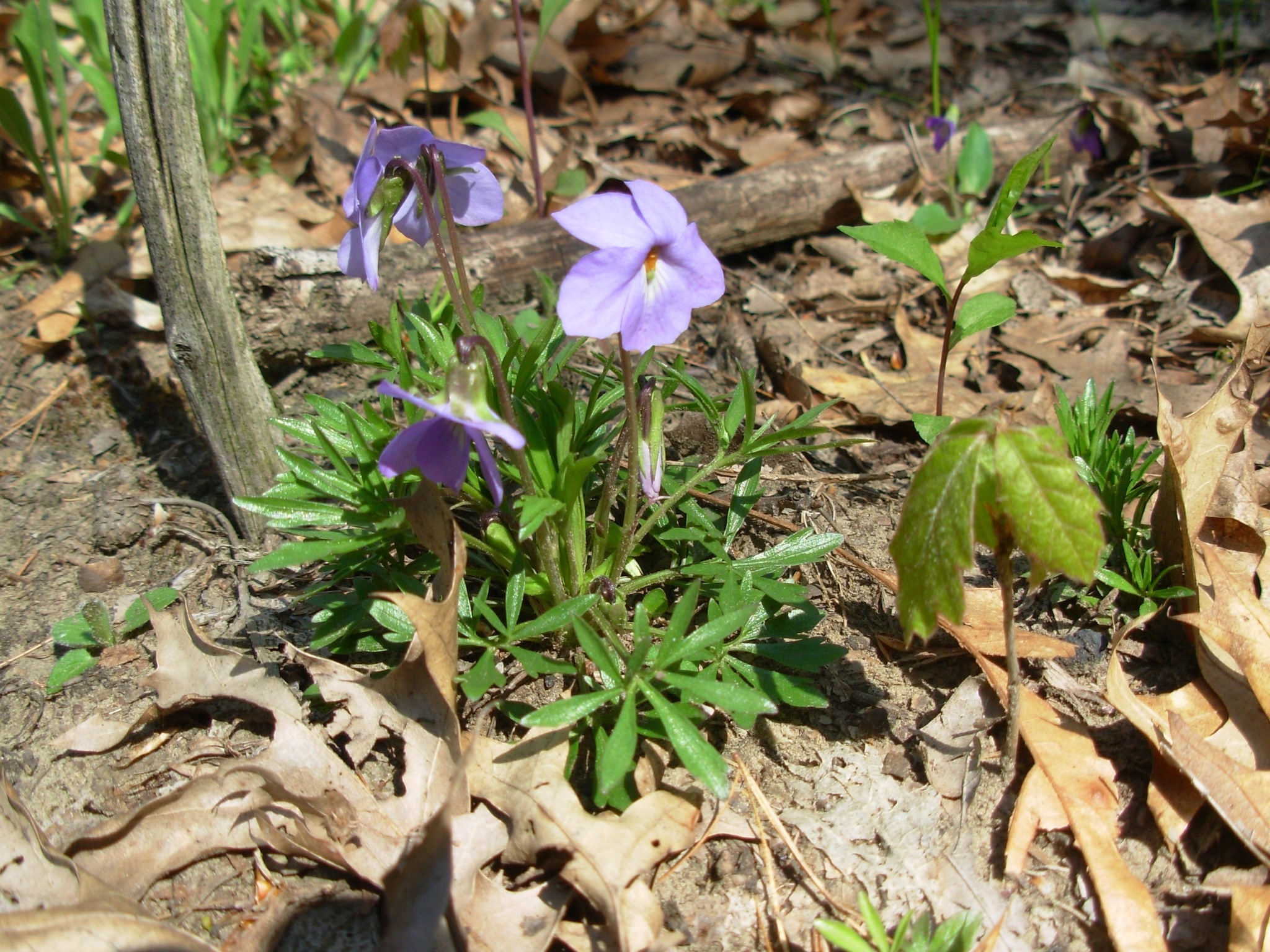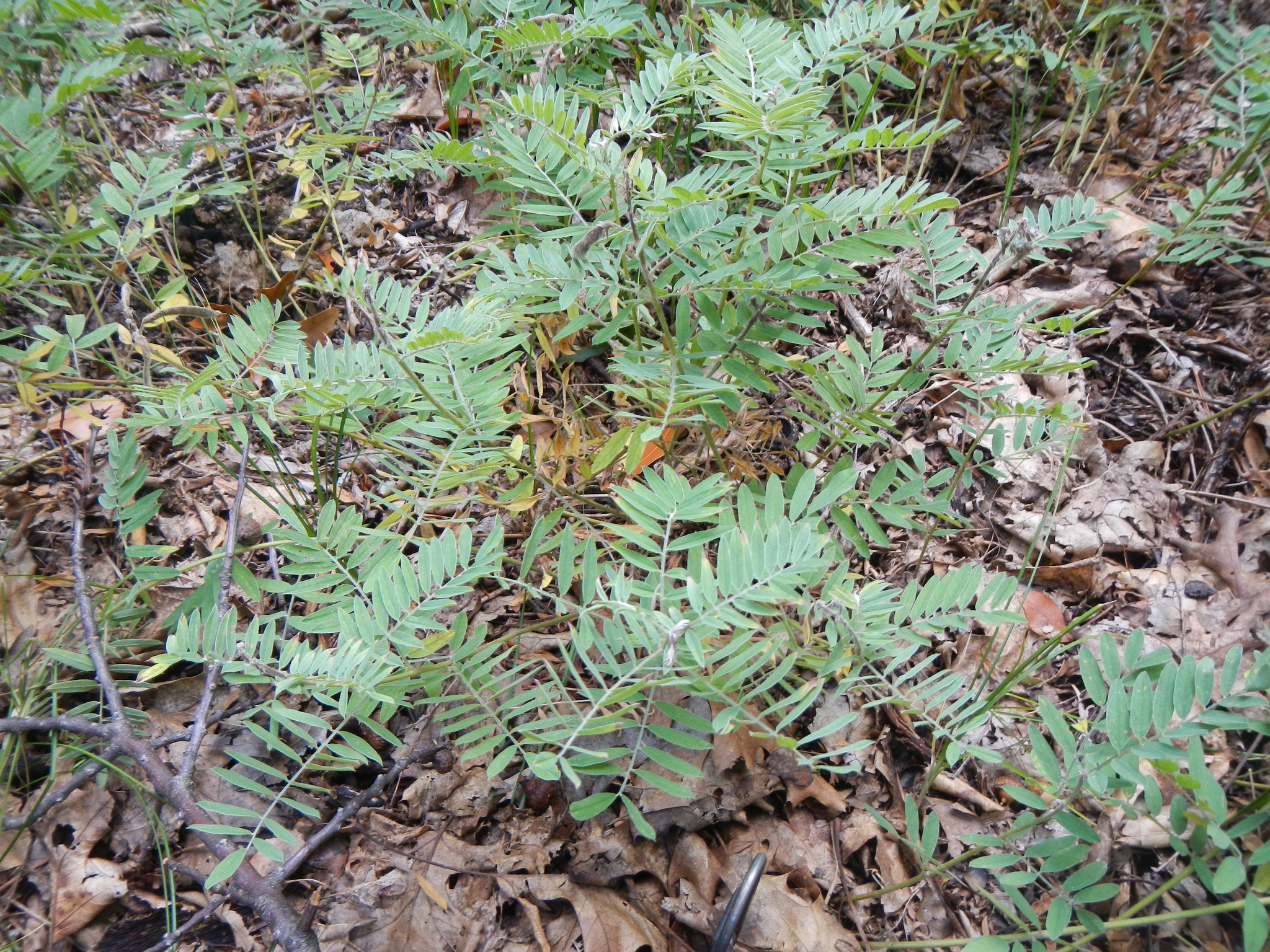Bird’s-foot Violet and Virginia Goat’s-rue

Photo credit: © J. Burke Korol CC BY-NC 4.0

Photo credit: © Colin Chapman CC BY-NC 4.0
Species information
The following is a report on progress made towards the protection and recovery of Bird’s-foot Violet (Viola pedata) and Virginia Goat’s-rue (Tephrosia virginiana) in Ontario from 2007 to 2018, based on species-specific policy. This report meets the legislative requirement for a review of progress under the Endangered Species Act, 2007 (ESA or “the Act”). Both Bird’s-foot Violet and Virginia Goat’s-rue are listed as endangered on the Species at Risk in Ontario (SARO) List under the ESA.
Bird’s-foot Violet and Virginia Goat’s-rue have been classified as species at risk in Ontario since 2004. They were originally classified as endangered species (in 2004), and retained their ‘endangered’ status under the ESA.
As endangered species, Bird’s-foot Violet and Virginia Goat’s-rue have been protected from being killed, harmed, harassed, captured or taken, under the ESA, since 2004.
In addition, the species’ habitats have been protected from being damaged or destroyed since June 30, 2013, based on the general definition of habitat in the ESA.
The species-specific policy for Bird’s-foot Violet and Virginia Goat’s-rue, known as the Government Response Statement (GRS), was published in 2014, and includes the government’s recovery goal for these species, and the actions and priorities it leads or supports to help achieve that goal. The GRS considers science advice provided in the recovery strategy (Bird’s-foot Violet Recovery Strategy; Virginia Goat’s-rue Recovery Strategy), when developing recovery actions for the species. As legislated in the Act, the purpose of this Review is to report on progress made towards implementing the protection and recovery actions in the GRS. The Review can also help identify opportunities to adjust and adapt the implementation of protection and recovery actions, to achieve the recovery goal for these species.
Further information about these two species, including the threats they face and actions being taken to help protect and recover these species, is available on the Government of Ontario webpages for Bird’s-foot Violet and Virginia Goat’s-rue. A summary of progress made towards the protection and recovery of Bird’s-foot Violet and Virginia Goat’s-rue, and an annual update on the species at risk program, are available on the Review of Progress towards the Protection and Recovery of Ontario’s Species at Risk webpage.
Snapshot
Progress towards the protection and recovery of Bird’s-foot Violet and Virginia Goat’s-rue
- The recovery goal for Bird’s-foot Violet and Virginia Goat’s-rue in Ontario, as stated in the Government Response Statement (GRS), is to
maintain the provincial population of each species at, or enable natural increases to, sustainable levels, and re-establish the species at sites they have historically occupied if feasible and appropriate.
- Progress has been made towards implementing all GRS government-led actions. Progress has also been made towards achieving all government-supported recovery objectives, and implementing associated actions. Examples of progress include:
- Restoring habitat, species monitoring, and research to determine best methods to achieve sustainable, or naturally increasing, populations of Bird’s-foot Violet or Virginia Goat’s-rue in St. Williams Conservation Reserve
- Testing optimal fuel loads and predicting fire behaviour to determine best conditions for conducting prescribed burns, an important tool for restoring habitat for tallgrass prairie species
- Enhancing the habitat of Bird's-foot Violet through invasive species control and prescribed burns on two private properties
- Engaging landowners at the community level to encourage local stewardship of the species’ habitat
- In alignment with the GRS, more work is required to investigate whether it is feasible and appropriate to re-establish Bird’s-foot Violet and Virginia Goat’s-rue at sites historically occupied by the species, and conduct surveys on additional private lands using a consistent, standardized methodology.
Occurrences and distribution
- Fourteen populations
footnote 1 of Bird’s-foot Violet have been documented in Ontario, of which four are considered extant, one is considered historicalfootnote 2 , and nine are considered extirpated. The extant populations are located in the area of Turkey Point Provincial Park and three other sites on private lands near Brantford, Forestville and Vittoria. - Six populations of Virginia Goat’s-rue have been documented in Ontario. One population is considered extant, two are considered historical and three are considered extirpated. The extant population is located within Turkey Point Natural Area (including St. Williams Conservation Reserve).
Government-supported stewardship projects
- Through the Species at Risk Stewardship Program, the Government of Ontario has enabled its stewardship partners to conduct 11 projects ($691,256) that have supported the protection and recovery of Bird’s-foot Violet and/or Virginia Goat’s-rue. One project focused exclusively on Bird’s-foot Violet, while the other 10 projects focused on multiple species at risk, including Bird’s-foot Violet and/or Virginia Goat’s-rue.
- The government’s support helped a stewardship partner involve 5 individuals who volunteered 44 hours of their time towards protection and recovery activities focused exclusively on Bird’s-foot Violet. The government’s support also helped stewardship partners involve 1,014 individuals who volunteered 17,627 hours of their time towards protection and recovery activities for species at risk, including Bird’s-foot Violet and/or Virginia Goat’s-rue. The estimated value of these voluntary contributions, as well as additional funding and in-kind support, is $931,430.
- Stewardship partners reported that, through their actions, 5,426 hectares of habitat were enhanced for Bird’s-foot Violet and/or Virginia Goat’s-rue as well as other species at risk that inhabit the same ecosystem.
- Stewardship partners reported providing outreach on multiple species at risk, including Bird’s-foot Violet and/or Virginia Goat’s-rue, to 626,400 individuals.
Supporting human activities while ensuring appropriate support for species recovery
- The Government of Ontario has issued one ‘protection and recovery’ permit for Bird’s-foot Violet under clause 17(2)(b) of the ESA.
- One activity has been registered for Bird’s-foot Violet under the ‘Threats to health and safety, not imminent’ section (s. 23.18) of Ontario Regulation 242/08.
Reporting on progress towards the protection and recovery of Bird’s-foot Violet and Virginia Goat’s-rue
Recovery Goal
The government’s goal for the recovery of Bird’s-foot Violet and Virginia Goat’s-rue in Ontario is to maintain the provincial population of each species at, or enable natural increases to, sustainable levels, and re-establish the species at sites they have historically occupied if feasible and appropriate.
The implementation of government-led and government-supported actions demonstrates progress towards reaching the desired objectives and the recovery goal set out in the GRS.
Progress towards implementing government-led actions
Progress has been made towards implementing all GRS government-led actions. Common actions for the government to lead as it works toward achieving a species’ recovery goal include:
- Educate other agencies and authorities involved in planning and environmental assessment processes on the protection requirements under the ESA.
- Encourage the submission of Bird’s-foot Violet and Virginia Goat’s-rue data to the government’s central repository at the Natural Heritage Information Centre (NHIC).
- Undertake communications and outreach to increase public awareness of species at risk in Ontario.
- Protect the Bird’s-foot Violet and Virginia Goat’s-rue and their habitat through the ESA.
- Support conservation, agency, municipal and industry partners, and Indigenous communities and organizations to undertake activities to protect and recover Bird’s-foot Violet and Virginia Goat’s-rue. Support will be provided where appropriate through funding, agreements, permits with appropriate conditions, and/or advisory services.
- Encourage collaboration, and establish and communicate annual priority actions for government support in order to reduce duplication of efforts.
Additionally, the government has directly undertaken the following species-specific actions:
- Continue to undertake periodic monitoring of Bird’s-foot Violet and Virginia Goat’s-rue populations, habitat conditions, and threats to the species and their habitat within Turkey Point Provincial Park.
- Continue to undertake ecosystem enhancement activities such as prescribed burning and invasive species control within Turkey Point Provincial Park, as resources permit.
- Continue to work with partners to undertake monitoring, habitat management, research to address significant knowledge gaps, and to increase awareness and promote stewardship of species at risk including Bird’s-foot Violet and Virginia Goat’s-rue in St. Williams Conservation Reserve.
- Continue to implement the Ontario Invasive Species Strategic Plan to address the invasive species (for example, Multiflora Rose (Rosa multiflora), Autumn Olive (Elaeagnus umbellata) and Garlic Mustard (Alliaria petiolata)) that threaten Bird’s-foot Violet and Virginia Goat’s-rue.
Bird’s-foot Violet and Virginia Goat’s-rue populations occur in the Turkey Point Natural Area (including St. Williams Conservation Reserve), where Ontario government staff have undertaken extensive habitat improvement activities, including restoration and invasive species control. The use of prescribed burning is a key habitat management tool for restoring oak savanna habitat, which is habitat where these species occur. Multiple burns have occurred within the park with positive results for the species’ populations.
Virginia Goat’s-rue is known to occur in the St. Williams Conservation Reserve where Ontario government staff have worked in cooperation with the St. Williams Conservation Reserve Community Council to restore oak savanna habitat and conduct inventory and monitoring activities. The St. Williams Conservation Reserve Community Council has worked closely with the Ontario government since 2009 to implement the St. Williams Conservation Reserve 10-Year Operations Plan that also includes invasive species removal and education and awareness as key priorities.
Key progress made towards implementing other government-led actions is described in the following sections.
Ontario’s Invasive Species Act
The GRS for Bird’s-foot Violet and Virginia Goat’s-rue indicates that invasive species (e.g., Garlic Mustard) pose a threat to the survival and recovery of the species in Ontario. The Ontario Invasive Species Strategic Plan, 2012 and the Invasive Species Act, 2015 provide the policy and legislative framework to support the prevention, detection and control of invasive species in Ontario. This framework may support the implementation of actions to reduce threats from invasive species.
Occurrences and distribution
Fourteen populations
Six populations of Virginia Goat’s-rue have been documented in Ontario, of which one is considered extant, two are considered historical, and three are considered extirpated. The extant population is located within Turkey Point Natural Area (including St. Williams Conservation Reserve). One population previously thought to be extant is now considered historical as the species was last observed in 1991.
Since 2008, the government’s central repository at the Natural Heritage Information Centre (NHIC) has received 195 records of Bird’s-foot Violet, based on observations made between 1880 and 2018, and 117 records of Virginia Goat’s-rue, based on observations made between 1885 and 2018. Observations for both species come from a variety of sources. Records submitted have helped to refine where the species are known and have been known to occur and have provided additional information on the species’ habitats and threats. For example, the populations of Bird’s-foot Violet in Turkey Point Provincial Park are considered to have excellent estimated viability
It is possible that there are observations of Bird’s-foot Violet and Virginia Goat’s-rue that have not been submitted to the government. Encouraging the submission of observations of these species is included in the GRS as a government-led action. Submission of species observations increases our knowledge of where they occur and can play an important role in assessing the viability of species populations.
Everyone is encouraged, or may be required by an authorization or approval, to submit observations of Bird’s-foot Violet and Virginia Goat’s-rue, and any other species at risk, to the NHIC for incorporation into the provincial record of observations. Observations may now be submitted to NHIC via the Rare Species of Ontario project in iNaturalist.
-
195observations of Bird's-foot Violet were submitted to the NHIC since 2008
-
117observations of Virginia Goat's-rue were submitted to the NHIC since 2008
Government-supported stewardship projects
An important government-led action in the GRS for Bird’s-foot Violet and Virginia Goat’s-rue is to support partners to undertake activities to protect and recover the species. Through the Species at Risk Stewardship Program the government has supported 11 projects ($691,256) designed to contribute to the protection and recovery of Bird’s-foot Violet and/or Virginia Goat’s-rue
Stewardship partners reported that provincial funding helped them to secure in-kind support by involving 5 individuals who volunteered 44 hours of their time towards protection and recovery activities that focused exclusively on Bird’s-foot Violet, which has an estimated value of $2,080. As well, 1014 individuals volunteered 17,627 hours of their time towards protection and recovery activities for multiple species at risk, including Bird’s-foot Violet and/or Virginia Goat’s-rue, which has an estimated value of $504,280. Partners also reported that through their efforts and those of their volunteers to implement GRS actions, they were successful in enhancing 5,426 hectares of habitat that will benefit multiple species at risk, including Bird’s-foot Violet and/or Virginia Goat’s-rue. In addition, stewardship partners reported providing ecosystem-based outreach on multiple species, including Bird’s-foot Violet and/or Virginia Goat’s-rue, to 626,400 individuals.
The remainder of this section highlights a multi-year project supported through the Species at Risk Stewardship Program.
Since 2017, the St. Williams Conservation Reserve Community Council has been implementing a multi-year project to protect and restore the oak savanna ecosystem, and associated habitats and species, in the St. Williams Conservation Reserve. The St. Williams Conservation Reserve protects one of the largest remaining oak savannas in Canada, that supports more than 24 species at risk including Bird’s-foot Violet and Virginia Goat’s-rue. The strategy of the project was to protect high-quality savanna remnant areas and restore degraded savanna areas to create a larger, connected savanna landscape within the Reserve. Project goals included protecting and recovering Bird’s-foot Violet and Virginia Goat’s-rue through site-specific habitat management actions, protecting, enhancing and monitoring sensitive oak savanna remnants, and increasing understanding of best practices for using assisted seed dispersal to expand the populations of these two species within the Reserve. Specific actions for Bird’s-foot Violet and Virginia Goat’s-rue completed during the first two years of this project included:
- Conducting detailed inventories for the species within the Reserve;
- Developing a proposed protocol for seed collection and dispersal for both plant species;
- Documenting population extent, habitat conditions and threats; and,
- Monitoring results of prescribed burns and conifer thinning conducted to enhance and restore the species’ habitat.
This multi-year project conducted work pertaining to several GRS actions to develop and implement site-specific management strategies, including managing and improving habitat, monitoring the effectiveness of these actions, regularly monitoring the species’ demographics, health, habitat conditions, and threats at all sites where they occur, and identifying best practices for propagation (including assisted dispersal of Bird’s-foot Violet and Virginia Goat’s-rue seeds).
Species at Risk Stewardship Program
-
 11
11projects included Bird's-foot Violet and/or Virginia Goat's-rue
-
 1
1project for Bird's-foot Violet exclusively
-
 $691,256
$691,256for multi-species projects that included Bird's-foot Violet and Virginia Goat's-rue
-
 $931,430
$931,430in additional funding and in-kind support
-
 1,014
1,014volunteers
-
 17,627
17,627volunteer hours
-
 626,400
626,400people received outreach
-
 5,426
5,426hectares of habitat enhanced
Supporting human activities while ensuring appropriate support for species recovery
Supporting partners through permits and their associated conditions is an important government-led action.
One ‘protection or recovery’ (17(2)(b)) permit has been issued for Bird’s-foot Violet since the species has been protected under the ESA. A ‘protection or recovery’ permit is issued if the purpose of the activity is to assist in the protection or recovery of a species at risk. The permit was issued to support a seed propagation project for tallgrass prairie plants. To date, no permits have been issued for Virginia Goat’s-rue.
One activity that may affect Bird’s-foot Violet or its habitat has been registered under various sections of Ontario Regulation 242/08 under the ESA. The activity was registered under ‘Threats to health and safety, not imminent’ (section 23.18). The registrant must comply with all conditions of the Regulation such as preparing a mitigation plan using best available information on steps that may help minimize or avoid adverse effects on the species; reporting species observations using the Ontario Species at Risk Observation Reporting Form and submit to the NHIC; and, relocating the plant to a nearby location within the species’ habitat that is suitable and safe, provided it is feasible to do so.
-
1protection or recovery permit
-
1registration
Progress towards implementing government-supported actions
Government-supported actions are organized under overarching recovery objectives. Progress has been made towards achieving all government-supported recovery objectives, and implementing the associated actions identified in the GRS for Bird’s-foot Violet and Virginia Goat’s-rue.
Objective: Improve habitat conditions and promote increases in the distribution and abundance of Bird’s-foot Violet and Virginia Goat’s-rue.
- Action No. 1 (High Priority) – Develop and implement site-specific management strategies to manage and improve habitat where these species occur, with consideration for other rare species and invasive species present on site. Monitor the effectiveness of actions taken and revise strategies, as appropriate, based on the best available information. Strategies may include, but are not limited to:
- prescribed burns to prevent woody succession
- woody vegetation removal (for example, where burns are not feasible)
- invasive species control
- Action No. 2 – Investigate whether it is feasible and appropriate to re-establish Bird’s-foot Violet or Virginia Goat’s-rue at sites historically occupied by the species, and where it is deemed feasible and appropriate, undertake actions to do so.
Under this objective, considerable progress has been made towards implementing Action No. 1, while initial progress has been made towards implementing Action No. 2, through several projects supported by the Species at Risk Stewardship Program that enabled extensive recovery work for these species in the St. Williams Conservation Reserve, Turkey Point Natural Area, and Turkey Point Provincial Park. Activities included habitat restoration, species monitoring, and research to determine best methods to achieve sustainable, or naturally increasing, populations of Bird’s-foot Violet or Virginia Goat’s-rue in these areas.
Objective: Increase knowledge about habitat management for Bird’s-foot Violet and Virginia Goat’s-rue, as well as factors influencing reproductive success and propagation.
- Action No. 3 (High Priority) – Undertake research to determine optimal conditions at which habitat management techniques should be conducted (for example, optimal temperature and frequency for prescribed burns).
- Action No. 4 – Undertake research to:
- determine factors influencing reproductive success of Bird’s-foot Violet and Virginia Goat’s-rue (for example, conditions under which pollination, germination, and recruitment are optimal; seed bank characteristics and longevity)
- identify the best practices for propagation (including assisted dispersal, cultivation, or transplantation) of these species
Under this objective, progress has been made towards implementing Action No. 3 through three projects supported by the Species at Risk Stewardship Program. Two projects involved testing optimal fuel loads and predicting fire behaviour regarding best practices for prescribed burns, an important tool for restoring habitat for tallgrass prairie plant species, including Bird’s-foot Violet and Virginia Goat’s-rue. Site-specific management recommendations for burns were then updated. The third project, whose goal was to enhance the habitat of Bird’s-foot Violet on two private properties, and encourage the persistence and recruitment of plants through invasive species control and prescribed burns, re-confirmed the presence of the species during post-burn monitoring.
Initial progress has been made towards implementing Action No. 4 – a project within the St. Williams Conservation Reserve developed a seed dispersal strategy for Bird’s-foot Violet, and monitored seed bank emergence for both plant species in burned-over areas.
Objective: Confirm where the species remain and improve understanding of the species and their habitat at these sites.
- Action No. 6 – Undertake regular monitoring of the species’ demographics, health, habitat conditions, and threats at all sites where they occur.
Under this objective, considerable progress towards implementing Action No. 6 through several stewardship projects. Both broad-scale and site-specific surveying and monitoring of Bird’s-foot Violet and Virginia Goat's-rue were undertaken across the species’ ranges. Intensive and targeted monitoring of plant populations, to assist with restoration planning and operations planning, occurred within St. Williams Conservation Reserve and Turkey Point Natural Area for several years. Knowledge of where these species occur within these managed areas informed the siting of recreational trails, including routing trails away from occurrence locations.
Objective: Increase awareness and stewardship of the species and their habitat.
- Action No. 7 – Increase awareness among land owners and the public about Bird’s-foot Violet and Virginia Goat’s-rue, including:
- identification of the species
- the species’ habitat requirements
- protection afforded to the species and their habitat under the ESA
- actions they can take to minimize threats, including habitat loss, invasive species, trampling, and erosion
Under this objective, considerable progress has been made towards implementing Action No. 7 through projects supported by the Species at Risk Stewardship Program. Stewardship partners have implemented educational workshops, site-specific habitat management planning, and volunteer recruitment and training for tallgrass prairie ecosystem recovery and the species this ecosystem supports, including Bird’s-foot Violet and Virginia Goat's-rue. Landowner engagement effort at the community level encouraged local stewardship of this very rare habitat.
Summary of progress towards meeting the recovery goal
The recovery goal for Bird’s-foot Violet and Virginia Goat’s-rue in Ontario is to “maintain the provincial population of each species at, or enable natural increases to, sustainable levels, and re-establish the species at sites they have historically occupied if feasible and appropriate.” Effort made towards implementing government-led and government-supported actions has contributed to progress towards this goal. These efforts include invasive species removal, habitat restoration through prescribed burns, species and habitat monitoring and surveys, and targeted landowner engagement. For example, considerable effort to develop and implement site-specific management strategies for the species’ habitats has been completed with support from the Species at Risk Stewardship Program. In particular, research was done to determine optimal conditions and methods for conducting prescribed burns, an important habitat management tool for sustaining populations of these species.
Recommendations
As stated in the GRS, this Review of Progress can be used to help identify whether adjustments to the implementation of GRS actions are needed to achieve the protection and recovery of the species. Based on progress to date, the overall direction provided in the GRS for Bird’s-foot Violet and Virginia Goat’s-rue, particularly the implementation of actions identified as high priority, should continue to guide protection and recovery of the species.
Although varying levels of progress have been made towards implementing all of the GRS actions for Birds-foot Violet and Virginia Goat’s-rue, further work is needed to fully implement these actions and contribute to the ongoing protection and recovery of this species.
Relative to actions that have received a stronger level of implementation, the following actions have received less implementation, and may be prioritized in future work towards the protection and recovery of the species:
- Action No. 2 – Investigate whether it is feasible and appropriate to re-establish Bird’s-foot Violet or Virginia Goat’s-rue at sites historically occupied by the species, and where it is deemed feasible and appropriate, undertake actions to do so.
- Action No. 5 – Survey the sites where Bird’s-foot Violet and Virginia Goat’s-rue occur on private land to confirm whether the species remain at these sites and, where they are found to remain, determine population sizes. Surveys should be conducted using a consistent, standardized methodology.
Protecting and recovering Bird’s-foot Violet and Virginia Goat’s-rue will continue to be a shared responsibility that will require the involvement of many individuals, organizations and communities. Financial support for the implementation of actions may be available through the Species at Risk Stewardship Program. The government can also advise if any authorizations under the ESA or other legislation may be required to undertake a project. By working together, we can continue to make progress towards protecting and recovering Bird’s-foot Violet and Virginia Goat’s-rue in Ontario.
Footnotes
- footnote[1] Back to paragraph For the purposes of this report, a population is defined as an area of land and/or water on/in which an element (e.g., Bird’s-foot Violet) is or was present. They are comprised of one or more observations and the area has a practical conservation value as it is important to the conservation of the species. An element occurrence is the technical term used to describe this.
- footnote[2] Back to paragraph A population is considered historical if it has not been recorded within the last 20 years. Historical populations may still exist but updated information is not available
- footnote[3] Back to paragraph Viability is defined as the probability that a population/occurrence will persist based on its size (including population size and/or occupied area), environmental conditions, and landscape context.
- footnote[4] Back to paragraph Some projects supported through the Species at Risk Stewardship Program may require a 17(2)(b) permit in order to carry out the project. As a result, some 17(2)(b) permits included in this report may have been issued to authorize those projects.